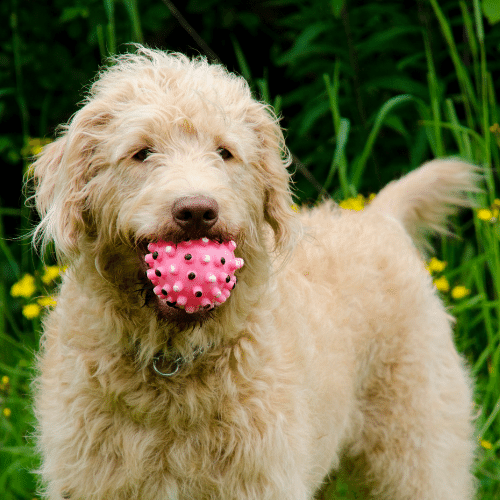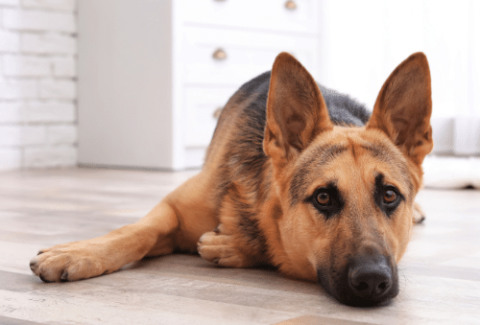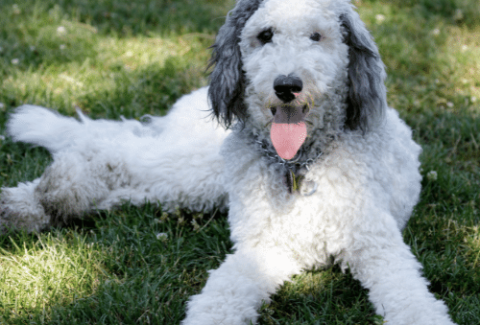At what age do Labradoodles calm down?
February 21, 2022 2022-02-21 6:23At what age do Labradoodles calm down?
Labradoodles, are one of the most popular crossbreeds in America. They’re adorable, good-natured, and fun-loving, but at what age do they calm down?
All young puppies experience a period of hyperactivity.
Labradoodles should calm down by around three years old. However, it winds down gradually as they grow, so don’t despair! The breed is also very bright, so they’re quick to learn right from wrong.
Let’s take a closer look at this hyperactive period and what to do if you’re grown-up Doodle is still hyperactive.
Table of Contents
What age do Labradoodles calm down?
Most Labradoodles reach adolescence at 6-8 months old and grow to their full adult size by 12 months of age, although they can take as long as 18 months to develop fully. They take a little longer to mature mentally, and may not be emotionally mature until 3 years old.
At that point they are a lot better at regulating their energy levels. That said, Doodles should remain relatively high-energy dogs as adults, well into their old age. However, being too hyper can cause problems.
Signs of hyperactivity in Labradoodles
Signs of hyperactivity in Doodles include fidgety movements, a short attention span, impulsiveness, attention-seeking behaviors, unprovoked snapping, aggression, and not being able to socialize well with other dogs.
Why is my Labradoodles so hyper?
Labradoodles are naturally high-energy, playful dogs. They are part Labrador Retriever, a very energetic breed, and part Poodle, one of the most intelligent breeds on the planet. The more intelligent a dog is, the more mental stimulation they tend to need to avoid getting bored.
So, naturally, Labradoodles need a lot of exercise and play. However, if your adult Doodle is extremely hyperactive, they may be understimulated and/or underworked. This can result in pent-up energy and hyperactivity. It can also lead to anxious and destructive behaviors, such as pacing, panting, excessive barking, and destroying personal and household items.
In order to fix (and prevent) this, you need to expend your Doodle’s energy sufficiently and in a healthy way, with lots of walks and play on a daily basis.
How much exercise does a Labradoodle need?
A healthy adult Labradoodle needs around an hour of exercise every day, preferably split into two walks. Doodles enjoy walking, running, hiking, and swimming, so try to vary the location and do different activities on your walks to keep them stimulated.
Labradoodle pups need to build up their exercise routine, with 5 minutes of exercise per month of their life twice a day. This may not seem like enough, but it’s essential you don’t overwork your developing Doodle’s body, as this can cause irreversible damage.
Elderly Doodles will need to slow down gradually as they age to prevent wearing down their joints, but your vet should let you know when it’s time to do this.

What do Labradoodles like to play?
Dogs love playing games that exercise their natural instincts. Historically, Labradors and Poodles were both bred to hunt, and primarily in water. So, Labradoodles love games like fetch and chase, and anything involving water. (Paddling pools are a good idea!)
Some other popular games for bright dogs include hide and seek, treasure hunt, and the cup game. To play hide and seek, ask your Labradoodle to sit and stay while you hide somewhere in your home. Then, call them to come and find you.
To play treasure hunt, follow the same rules but hide your dog’s favorite toy or some treats instead. To play the cup game, place two empty cups face down on the floor in front of your Doodle, and put a treat underneath one of them. Switch the cups around and ask your dog to find them.
It’s also a great idea to invest in some mentally stimulating toys, such as plush puzzles, puzzle feeders, snuffle mats, and treat dispensers. We highly recommend pet brand Outward Hound’s puzzle products. Toys that stimulate the senses are great, too, especially for younger Doodles.
The importance of socialization
Socialization is very important for dogs of all kinds, but especially super-social breeds like Labradoodles. Not only is it essential for their well-being, but it is also very stimulating and will burn up a lot of their daily energy.
Try to involve your dog in your family life as much as possible, and interact with lots of friendly people and dogs on walks.
It’s best to begin socialization during your dog’s puppyhood, and start at home so that they can learn the rules in a safe environment. This will also prevent aggressive behavior and snapping during periods of hyperactivity.
Ideally your breeder will have already started some socialization and exposure with the puppy (such as to different sounds and surfaces) before you bring him or her home.
Training a hyper Labradoodle
Hyperactivity can make training a dog difficult, but not impossible. The key is to harness their energy and playfulness, rather than try to suppress it or punish them for it. Start training your Labradoodle as early on in their life as possible and try to keep your training sessions concise, consistent, regular, and fun to avoid stubbornness.
Positive reinforcement, like praise and treats, should always be the driving force in your training, and using a behavioral marker, like a clicker, will speed up the process by letting your dog know exactly what they’re doing right.
How to calm down a Labradoodle?
If your Labradoodle is experiencing hyperactivity, the best thing you can do is remain calm and be firm in your commands and/or actions in response to your dog’s behavior. Don’t react angrily or yell, as an energetic response could not only elevate your dog’s emotions but could also ruin your bond.
If your dog behaves badly, ignoring them by crossing your arms and turning away from them is the best response. Once they calm down, you should reward them for their calm behavior, so that they understand that this is what you want.
If your Doodle’s extreme hyperactivity is due to anxiety or if you just feel like you need a little extra help, you could try using a calming herbal supplement or a plug-in diffuser. They use naturally soothing ingredients like CBD and lavender to bring down stress levels and relax the body and mind. There are also calming collars and beds that emit calming scents and provide a sense of security.
Labradoodles have an intense chewing desire and can show hyperactivity if they don’t have the right outlet for it.

Do Labradoodles make good family dogs?
With the right training, Labradoodles make great family dogs, hence why they’re such a popular mix. Their high-energy, playful nature makes them ideal for large families, active families, and families that love to have fun and explore. They’re also great with young children and other family pets.
However, because of their training and exercise needs, they are not ideal dogs for first-time dog owners.
Is separation anxiety common in Labradoodles?
Separation anxiety is fairly common in Labradoodles, especially those that are also experiencing hyperactivity. This is because the most common cause of hyperactivity in dogs also causes separation anxiety. Separation anxiety can be treated (and prevented) by tackling under-stimulation and also by building your dog’s independence and confidence.
You can do this by leaving your Doodle alone for short periods of time, and gradually building up the time that you are apart. This will create trust and understanding with your dog that you will always come back. It’s also a good idea to create a positive association with alone time by providing a fun solo-play toy like a treat dispenser and giving it to your Doodle whenever you leave the house.
You don’t need to make a big deal about leaving, as this could heighten their emotions, but you should always make a big fuss of your dog when you come back. This lets them know that there is something to look forward to the next time you leave.
You can also relieve some anticipatory anxiety by doing some of the things you commonly do before leaving the house, such as grabbing your keys or turning off the TV, and then not leaving to remove the association.
If your dog is destructive at first, try putting them in a crate or confining them to a safe area of the home with a dog gate. Although it is frustrating, don’t react angrily, as the attention may encourage their behavior. It’s far more effective to show them that this kind of behavior gets no attention at all, and don’t forget to reward them when they get it right!
Can Labradoodles be low-energy?
Labradoodles are generally high-energy dogs. If your Doodle appears to be lethargic or experiences a sudden change in their energy levels, you should watch for other physical symptoms and behavioral changes and take them to the vet for an examination if you’re worried. Several health conditions can cause low energy in dogs, including infections, diseases, allergies, and hormonal disorders.
The bottom line
There’s no reason to be afraid of a high-energy dog, so long as you are willing to put in the time, love, and effort to prevent them from getting bored. As long as you can meet their needs, the lovely Labradoodle makes a wonderful companion and a great family pet!

Laura
Writer and Border Collie Mom
Laura is a dog-lover with an animal-related degree and plenty of hands on experience. She is passionate about dog health & welfare and wants to arm owners with all of the essential info they need!
Steffi Trott
Related Posts
Are Labradoodles High-Maintenance?
Are Pomeranians Good for First-Time Dog Owners?
Are German Shepherds Hypoallergenic?
Are German Shepherds Smart?
Are German Shepherds Vocal?
Are German Shepherds Good With Kids?
Do Bernedoodles like Water?
Do Bernedoodles Like Cats?
How Long Can Australian Shepherds Be Left Alone?
How Much Exercise Does a Cavachon Need?
Check out our effective and affordable online dog training courses!
-
Sale Product on sale
 Tackling Reactivity Bundle
Tackling Reactivity Bundle
MONEY BACK GUARANTEE$564.00$49.00 -
Sale Product on sale
 Perfect Obedience Bundle
Perfect Obedience Bundle
MONEY BACK GUARANTEE$349.00$49.00 -
Sale Product on sale
 Ultimate Puppy Bundle
Ultimate Puppy Bundle
MONEY BACK GUARANTEE$416.00$49.00 -
Sale Product on sale
 The Perfect Focus Bundle
The Perfect Focus Bundle
MONEY BACK GUARANTEE$445.00$169.00 -
Sale Product on sale
 Ultimate Masterclass Bundle
Ultimate Masterclass Bundle
MONEY BACK GUARANTEE$2,213.00$499.00











